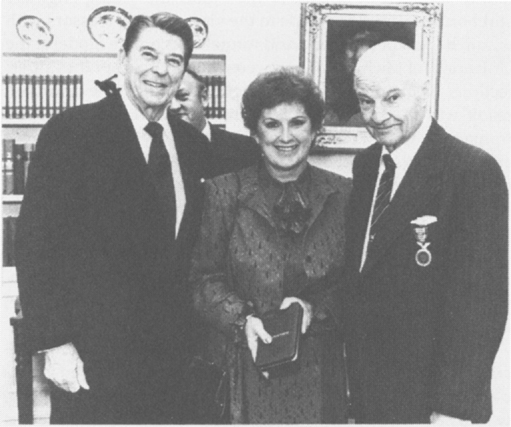
CLARENCE L. “KELLY” JOHNSON is the designer of the world’s highest-performance aircraft—the big bold “Blackbirds,” the SR-71 and YF-12—that were flying secretly at three times the speed of sound while other experts still were insisting that it was not feasible; and the graceful, glider-like U-2, which can attain altitudes admitted to be “above 80,000 feet.”
He designed America’s first operational jet fighter, the F-80 Shooting Star. His dramatic twin-boomed P-38 Lightning fighter-interceptor of World War II was the first aircraft to encounter the phenomenon of “compressibility” as the wing’s leading edge built up supersonic air turbulence. He has contributed to the design of more than 40 aircraft, more than half being his original design.
He holds every aircraft design award in the industry, some for the second and third time: the National Medal of Science; the National Security Medal; and the Medal of Freedom, the highest civil honor the President of the United States can bestow.
His “Skunk Works” at Lockheed—more formally, Advanced Development Projects—is recognized worldwide as unique in its record for turning out “breakthrough” designs in minimal time and with maximum security. “Be quick, be quiet, be on time,” are Kelly’s watchwords.
When the Russians in 1960 exhibited to the public in Red Square the wreckage of the aircraft they billed as the U-2 in which they had downed Francis Gary Powers, Kelly’s response to press query when shown the photo was typically direct and dramatic: “Hell, no,” the aircraft designer barked. “That’s no U-2.”

With wife Nancy Johnson, during 1983’s presentation by President Ronald Reagan of the National Security Medal.
The Russians had downed the U-2, untouchable for years at its high altitude on reconnaissance flights over Russian territory; but Kelly blew their act. A designer who went into the factory and participated in every phase of design and development as well as production, he recognized immediately that the mangled parts the Russians had displayed were not from any U-2.
Controversy is nothing new to this much honored engineer.
In his first day as a just-graduated engineer on the job that was to last 44 years, he told his employers that the new, all-metal aircraft with which they planned to challenge the air transport field was unstable! While such instability was commonly accepted in aircraft of the 1930s, the young engineer stubbornly refused to accede to the view of the professors with whom he had performed wind tunnel tests on the model at the University of Michigan. They were willing to accept the imperfections. Kelly was not. He was right, of course. The reworked result was the first in the long line of twin-tailed Lockheed transports that would make the company’s name known around the world in the 1930s and ’40s. This characteristic behavior soon earned him the nickname, “the Old Goat,” among the Lockheed engineering staff.
Kelly always held to his principles.
He advised the U.S. Navy in the early ’50s that a vertically-rising aircraft for which his company had a development contract was unsafe, with the limited engine power then available, and should be abandoned.
He refused to go ahead with a hydrogen-powered aircraft—ahead of its time in the late ’50s—and he turned back a development contract after initial work indicated the plane would be a “wide-bodied dog,” in the words of his successor at ADP.
He returned to the U.S. government approximately $2 million saved on the $20 million U-2 contract, having produced an extra six aircraft for the same money intended to cover 20 aircraft.
“I have known what I wanted to do ever since I was 12,” Johnson says.
Now officially retired, he continues in an advisory capacity at Lockheed, where he maintains an office in the “Skunk Works.” He still works to a busy schedule, though not always now beginning at his once customary 6 a.m., the better to communicate with East Coast military offices operating with a three-hour headstart.
This book is not intended to be a history of aviation nor a documentation of specific aircraft development. It is the personal reflection of one man in his time.
Maggie Smith
Sherman Oaks, Calif.